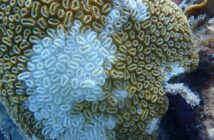
Sea and Reef has just released the 11th designer longfin clownfish. The new fish is a longfin version of the very popular Snow Storm Clownfish. As Manny aquarists know, longfin clownfish are not new to the hobby, but Sea & Reef’s new Longfin Clownfish have a much different look to them. Their longfin clownfish have long flowing fins with a rounded, more even outlines. This sets them apart from the typical longfin strain that display jagged, stiff fins with uneven edges often observed from other clownfish breeders.
The reason for the different look of Sea & Reef’s longfin clownfish is due to different genetics. It was bound to happen that the Storm Clownfish gene and the Longfin gene were to meet at some point. Marine Biologist, Soren Hansen, “observed with great excitement the very first batch of Longfin Mocha Storm Clownfish as they went through metamorphosis and grew their beautiful, even-edged fins”. They quickly revealed some spectacular pattern variations.
The creation of our Longfin Snow Storm Clownfish
The mutation created the longfin clownfish came from a single fish. In December 2013 their Hatchery Manager Brandon Weik was looking into a tank of several thousand Black and White Ocellaris (also called Darwin Ocellaris). He spotted a fish that looked very different than his brothers (all clownfish are born male). It had long flowing fins and was getting beaten up, probably because of its different look. The fish was isolated and later paired up. A story was published about their findings in Reef Builders in April 2014. Since 2013 Sea & Reef Aquacture has produced numerious variations of Longfin Clownfish. The Longfin Sow Storm Clownfish was created by breeding the Longfin Black Storm Clownfish with a Phantom Clownfish.
Temperament & Captive Care
The temperament and captive care requirements for the Longfin Snow Storm Clownfish is very similar to that of the regular Ocellaris clownfish. It is relatively peaceful and hardy. They thrive in saltwater aquariums with or without an anemone present.
Feeding
Most clownfish are omnivorous feeders, meaning that they will consume a variety of different food types. In nature the diet of clownfish consists of crustaceans (such as copepods and amphipods), algae, polychaete worms, and leftovers from the anemone’s meal. Sea & Reef captive bred fish are conditioned to eat a variety of aquarium diets including pellets, flake food, frozen Mysis shrimp, and frozen brine shrimp and more.
Aquarium Host Anemones
Longfin Snow Storm Longfin Clownfish will readily accept a wide variety of host anemones and many hobbyists keep them with the popular and hardy Bubble Tip Anemone (Entacmaea quadricolor). As a reference the natural host anemones of the regular ocellaris clownfish are Magnificent Sea Anemone (Heteractis magnifica), Giant Carpet Sea Anemone (Stichodactyla gigantean) and Merten’s Carpet Sea Anemone (Stichodactyla mertensii).
Visit the Sea & Reef website to learn more about the different types of ornamental fish that they currently breed. Sea & Reef does not sell to the general public but our sister company, Aquarium Specialty, carries Sea & Reef captive breed fish and we couldn’t be more pleased with the quality of their fish and we will be sure to bring in some of these on our next stock order.





